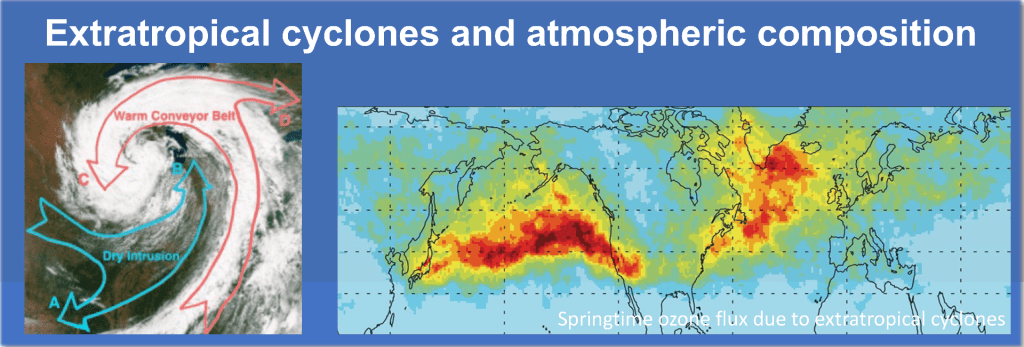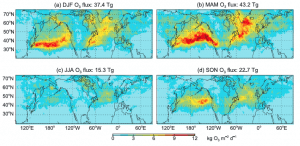 Extratropical cyclones are some of the most prolific cloud and rain producing systems in the extratropics. In addition to being key players in Earth’s climate and weather, extratropical cyclones affect atmospheric composition by vertically redistributing and scavenging trace gases and aerosols. We have combined satellite observations and models to examine the role of extratropical cylones in stratosphere-troposphere exchange of ozone and in affecting the distribution of aerosols.
Extratropical cyclones are some of the most prolific cloud and rain producing systems in the extratropics. In addition to being key players in Earth’s climate and weather, extratropical cyclones affect atmospheric composition by vertically redistributing and scavenging trace gases and aerosols. We have combined satellite observations and models to examine the role of extratropical cylones in stratosphere-troposphere exchange of ozone and in affecting the distribution of aerosols.
Some of our findings:
Jaeglé, Wood, and Wargan (2017). Multiyear composite view of ozone enhancements and stratosphere-to-troposphere transport in dry intrusions of northern hemisphere extratropical cyclones. Journal of Geophysical Research. PDF. We examine the role of extratropical cyclones in stratosphere‐to‐troposphere exchange with cyclone‐centric composites of  ozone (O3) retrievals from the Microwave Limb Sounder (MLS) and the Tropospheric Emission Spectrometer (TES), contrasting them to composites obtained with the Modern‐Era Retrospective‐analysis for Research and Applications (MERRA and MERRA‐2) reanalyses and the GEOS‐Chem chemical transport model. We estimate that extratropical cyclones result in a flux of 119 ± 56 Tg ozone/yr from the stratosphere to the troposphere,
ozone (O3) retrievals from the Microwave Limb Sounder (MLS) and the Tropospheric Emission Spectrometer (TES), contrasting them to composites obtained with the Modern‐Era Retrospective‐analysis for Research and Applications (MERRA and MERRA‐2) reanalyses and the GEOS‐Chem chemical transport model. We estimate that extratropical cyclones result in a flux of 119 ± 56 Tg ozone/yr from the stratosphere to the troposphere,  accounting for 42 ± 20% of the NH extratropical ozone stratosphere-to-troposphere flux.
accounting for 42 ± 20% of the NH extratropical ozone stratosphere-to-troposphere flux.
Robinson, Jaeglé, and Oman (2023). The role of midlatitude cyclones in the emission, transport, production, and removal of aerosols in the Northern Hemisphere. Journal of Geophysical Research. This study combines satellite observations of aerosol optical depth (AOD) from the MODIS sensor on Aqua and the M2GMI simulation to probe the influence of midlatitude cyclones on aerosols. We generate cyclone-centered composites by averaging together 27,707 individual Northern Hemisphere cyclone between 2005 and 2018. Results show that the total column amount of aerosol within the rain-producing part of cyclones is enhanced and that most of this enhancement is in the form of smaller aerosol particles more likely associated with human activities. Cyclone region and season play a large role in the abundance of aerosol, with springtime cyclones downwind of Asia displaying the largest abundances. We find that strong winds within cyclones account for over half of the annual direct emission of sea salt aerosol over the NH oceans. Furthermore, we show that midlatitude cyclones efficiently remove aerosol, accounting for 27%–33% of the total over the NH ocean basins. They also account for 27% of secondary production of sulfate and facilitate aerosol transport.

People: Joe Robinson, Lyatt Jaeglé with collaborators Rob Wood, Luke Oman, Kris Wargan
Funding: NASA, Atmospheric Chemistry Modeling and Analysis Program (ACMAP)
Publications:
- Robinson, J., Jaeglé, L., Oman, L. D., 2023. The role of midlatitude cyclones in the emission, transport, production, and removal of aerosols in the Northern Hemisphere, J. Geophys. Res.-Atmospheres, 128, e2022JD038131. https://doi.org/10.1029/2022JD038131
- Jaeglé, L., Wood, R., Wargan, K., 2017. Multiyear Composite View of Ozone Enhancements and Stratosphere-to-Troposphere Transport in Dry Intrusions of Northern Hemisphere Extratropical Cyclones. J. Geophys. Res.-Atmos. 122, 13436–13457. https://doi.org/10.1002/2017JD027656. Highlighted in EOS.